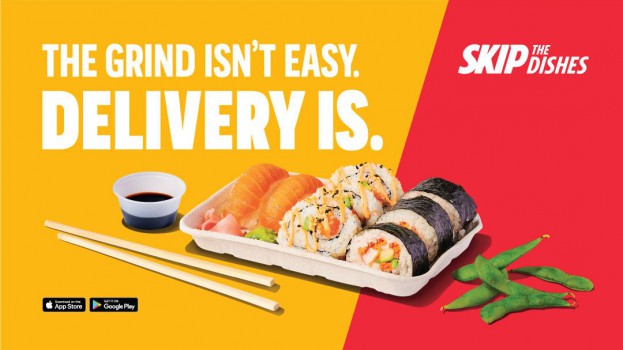Behind the Buy: SkipTheDishes skips to a new OOH strategy
With a focus on reinforcing Canadians' affinity for the service, Skip has embarked on its priciest OOH buy yet – but is using a different tactic.

The use of meal delivery apps are on the rise – and, as such, so is their media activity.
UberEats has entered into sports sponsorships and engaged in experiential plays; Foodora has been less active in paid media but embraced voice ordering last year. As an effort to establish itself as the preeminent Canadian meal delivery service (and being the only one of the major services to be Canadian-owned), Winnipeg-headquartered SkipTheDishes is also upping its spend this season.
Skip – as well as the other services – also enjoy exposure from media buys through their partnered restaurants; when QSR Wendy's recently paired with SkipTheDishes in Toronto, it was Wendy's that upped its radio spend and launched an OOH campaign to mark the milestone.
But it behooves Skip, UberEats and its competitors to also make a name for themselves and stand out from competitors and get Canadians to choose one over the other. So in September, the service launched a major campaign of its own, centering around OOH. Skip is keeping mum on how much exactly it invested in the campaign, but Kendall Bishop, director of marketing, confirmed to CARD that it is its biggest OOH investment to date.
"It was really the time for us to launch the biggest, most bad-ass out-of-home activation," Bishop says, with the bulk of its spend on a four-week-long subway domination at Toronto's Yonge-Dundas square.
The station is dominated by punchy, colourful creative, filled with food photos (naturally) and messaging about Skip being the preferred meal delivery service. Skip's own research, which involves a study commissioned in September, has Skip hailed as the most popular food delivery app in Canada. That claim is tough to verify as few of the apps make their specific market stats public. However, a recent BrandSpark survey of Canadian consumers found Skip to be the most trusted among food delivery apps.
The buy, brokered through Skip's MAOR True Media, represents a slight shift in Skip's overall OOH strategy. Having typically spent much of its paid media efforts trying to reach car commuters, says Bishop, most of its buys have been street-level billboards and posters of different sizes.
But it's attempting to increase its affinity among the key demo of "really busy downtowners who commute and use other forms of transportation." The station domination, she says, is an obvious way to do just that.
It also represents a new approach the brand is trying out. Bishop says the brand has pivoted from a land grab mentality to a more splashy, spectacular activation-focused strategy. "We've pivoted from buying enough faces to draw frequency of messaging to focusing on buying high-profile faces."
It's always been a big spender on radio and especially TV; unlike OOH Bishop says there's less seasonality to its TV buying activity. "You'll rarely find a time period in the year when our broadcast spots aren't out," she says, noting that the scale of its TV buying does vary by the season.
But with fall being busy season ("The less comfortable it is outside, the more people are willing to pay to have food delivered," says Bishop), the brand did launch new TV creative concurrently with its subway takeover. The TV campaign, the brand's second featuring U.S. actor Jon Hamm (who is not a marketing expert but plays one on TV) is also focused on educating the market about its product and reinforcing its market position. The spot is also aimed at millennials, and is paired against high-profile premieres like Survivor and Modern Family, as well as the finale of Big Brother Canada.
Additionally, the campaign is complemented by custom digital content on Facebook, Instagram and Snapchat.
TAGS: CARD
